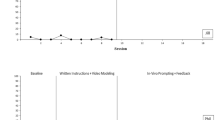Abstract
We evaluated the use of a video prompting procedure for teaching three adults with developmental disabilities to make popcorn using a microwave oven. Training, using a 10-step task analysis, was conducted in the kitchen of the participant’s vocational training program. During baseline, participants were instructed to make popcorn, but were given no further instructions or prompts. Video prompting consisted of first watching a video clip of a step being performed and then giving participants the opportunity to imitate that step. This prompting procedure was introduced in a delayed multiple-probe across subjects design. Following acquisition, video prompting was removed and maintenance in the absence of video prompting was assessed at 2, 6, and 10 weeks. Two of the three participants acquired the task when video prompting was introduced and performed at 80–100% correct during follow-up sessions. These data suggest that video prompting may be an effective instructional strategy for teaching daily living skills to adults with developmental disabilities.
Similar content being viewed by others
References
Charlop, M. H., & Milstein, J. P. (1989). Teaching autistic children conversational speech using video modeling. Journal of Applied Behavior Analysis, 22, 275–285.
Charlop-Christy, M. H., & Daneshvar, S. (2003). Using video modeling to teach perspective taking to children with autism. Journal of Positive Behavior Interventions, 5, 12–21.
D’Ateno, P., Mangiapanello, K., & Taylor, B. A. (2003). Using video modeling to teach complex play sequences to a preschooler with autism. Journal of Positive Behavior Interventions, 5, 5–11.
Duker, P. C., Didden, R., & Sigafoos, J. (2004). One-to-one training: Instructional procedures for learners with developmental disabilities. Austin, TX: Pro-Ed.
Ferster, C. B. (1967). Arbitrary and natural reinforcement. Psychological Record, 17, 341–347.
Haveman, M., van Berkum, G., Rejinders, R., & Heller, T. (1997). Differences in service needs, time demands, and caregiving burden among parents of persons with mental retardation across the life cycle. Family Relations: Interdisciplinary Journal of Applied Family Studies, 46, 417–525.
Horner, R. D., & Baer, D. M. (1978). Multiple-probe technique: A variation of the multiple baseline. Journal of Applied Behavior Analysis, 11, 189–196.
Jacobson, J. W., & Ackerman, L. J. (1990). Differences in adaptive functioning among people with autism or mental retardation. Journal of Autism and Developmental Disorders, 20, 205–219.
Kinney, E. M., Vedora, J., & Stromer, R. (2003). Computer-presented video models to teach generative spelling to a child with autism spectrum disorder. Journal of Positive Behavior Interventions, 5, 22–29.
Kraijer, D. (2000). Review of adaptive behavior studies in mentally retarded persons with autism/pervasive developmental disorder. Journal of Autism and Developmental Disorders, 30, 39–47.
Le Grice, B., & Blampied, N. M. (1994). Training pupils with intellectual disability to operate educational technology using video prompting. Education and Training in Mental Retardation and Developmental Disabilities, 29, 321–330.
Nikopoulos, C. K., & Keenan, M. (2003). Promoting social initiation in children with autism using video modeling. Behavioral Interventions, 18, 87–108.
Norman, J. M., Collins, B. C., & Schuster, J. W. (2001). Using an instructional package including video technology to teach self-help skills to elementary students with mental disabilities. Journal of Special Education Technology, 16, 5–18.
Parmenter, T. R. (1994). Quality of life as a concept and measurable entity. Social Indicators Research, 33, 9–46.
Peterson, C., & Bossio, L. M. (1989). Learned helplessness. In R. C. Curtis (Ed.), Self-defeating behaviors: Experimental research, clinical impressions, and practical implications (pp. 235–257). New York: Plenum Press.
Rehfeldt, R. A., Dahman, D., Young, A., Cherry, H., & Davis, P. (2003). Teaching a simple meal preparation skill to adults with moderate and severe mental retardation using video modeling. Behavioral Interventions, 18, 209–218.
Richards, S. B., Taylor, R. L., Ramasamy, R., Richards, R. Y. (1999). Single subject research: Application in educational and clinical settings. Belmont, CA: Wadsworth.
Skinner, B. F. (1968). The technology of teaching. Englewood cliffs, NJ: Prentice-Hall.
Sparrow, S. S., Balla, D. A., & Cicchetti, D. V. (1984). Vineland Adaptive Behavior Scales: Interview Edition Survey Form. Circle Pines, MN: American Guidance Service.
Sturmey, P. (2003). Video technology and persons with autism and other developmental disabilities: An emerging technology for PBS. Journal of Positive Behavior Interventions, 5, 3–4.
Wert, B. Y., & Neisworth, J. T. (2003). Effects of video self-modeling on spontaneous requesting in children with autism. Journal of Positive Behavior Interventions, 5, 30–34.
Westling, D. L., & Fox, L. (2004). Teaching students with severe disabilities (3rd ed.). Upper Saddle River, NJ: Pearson.
Wheeler, A. J., Miller, R. A., Springer, B. M., Pittard, N. C., Phillips, J. F., & Myers, A. M. (1997). Murdoch Center Program Library (3rd ed.) Butner, NC: Murdoch Center Foundation, Incorporated.
Author information
Authors and Affiliations
Corresponding author
Rights and permissions
About this article
Cite this article
Sigafoos, J., O’Reilly, M., Cannella, H. et al. Computer-Presented Video Prompting for Teaching Microwave Oven Use to Three Adults with Developmental Disabilities. J Behav Educ 14, 189–201 (2005). https://doi.org/10.1007/s10864-005-6297-2
Issue Date:
DOI: https://doi.org/10.1007/s10864-005-6297-2




